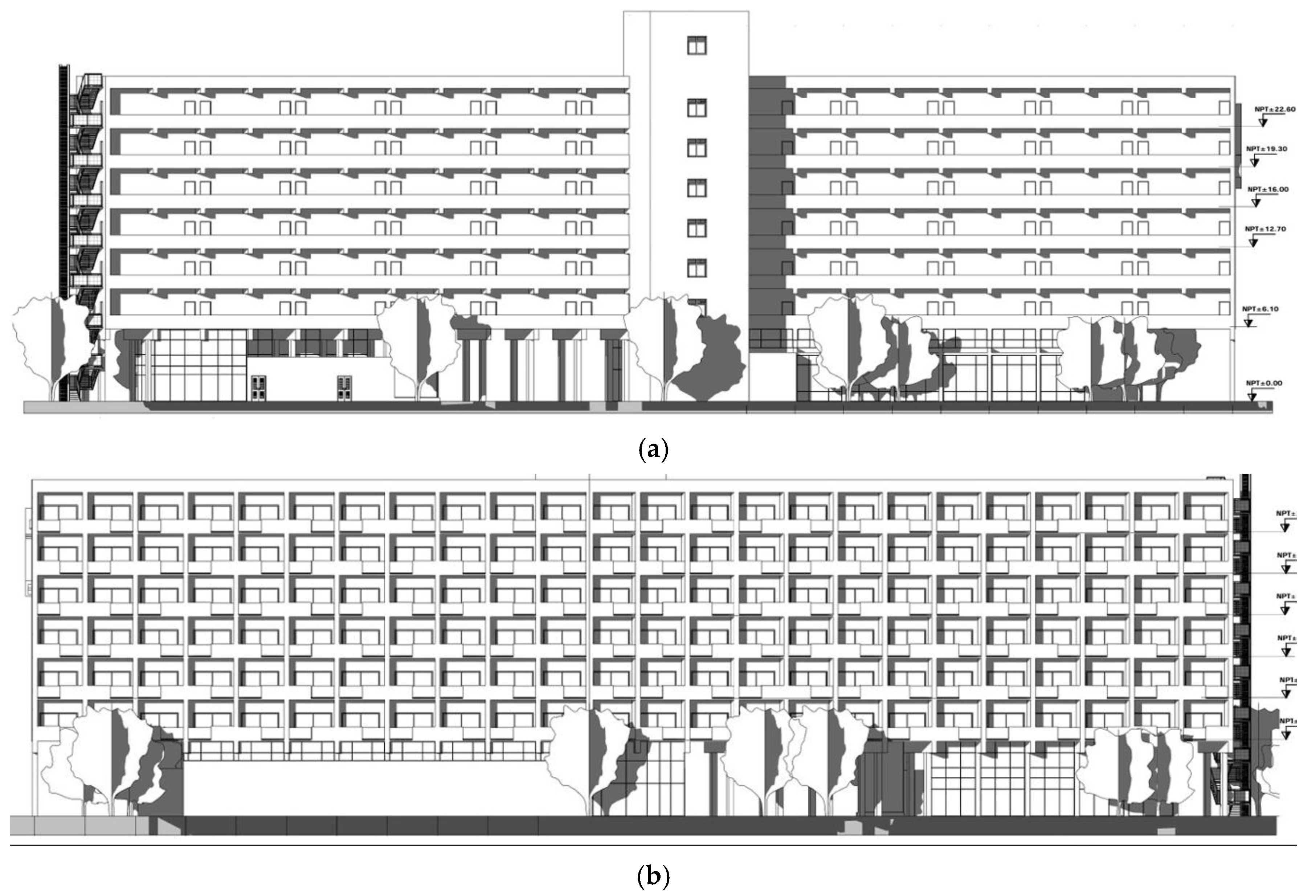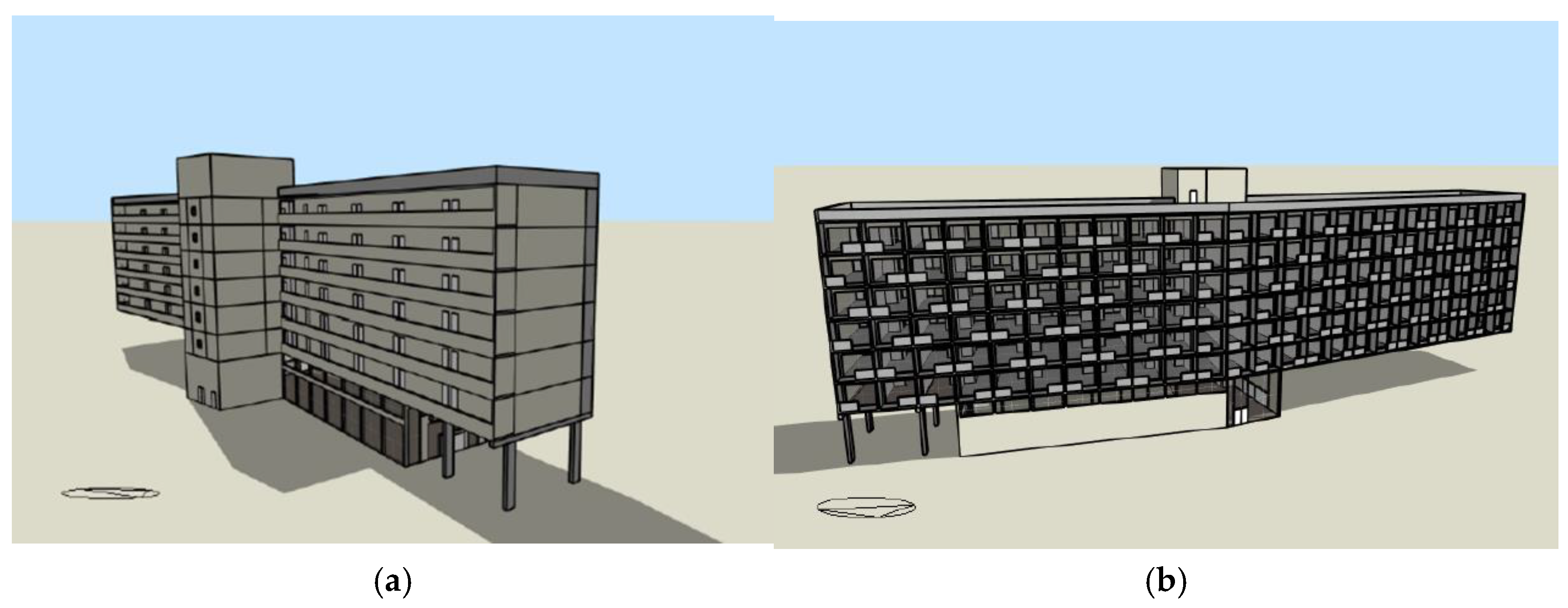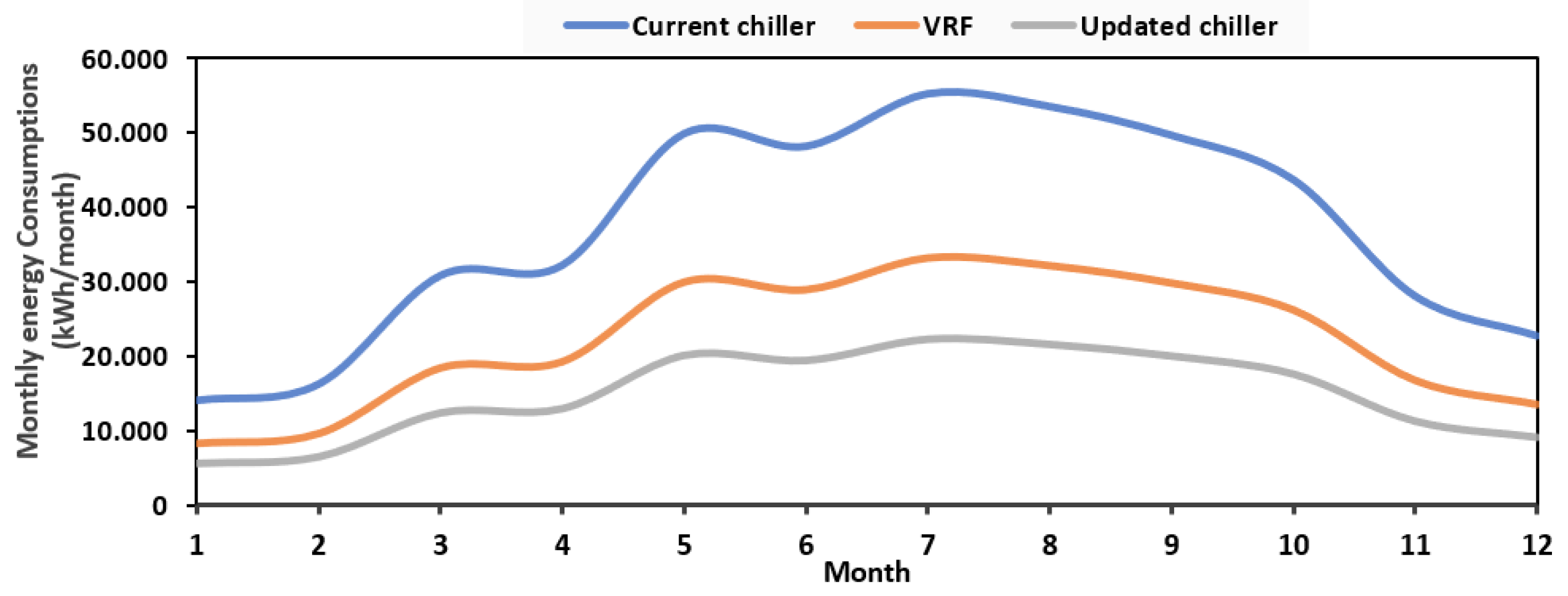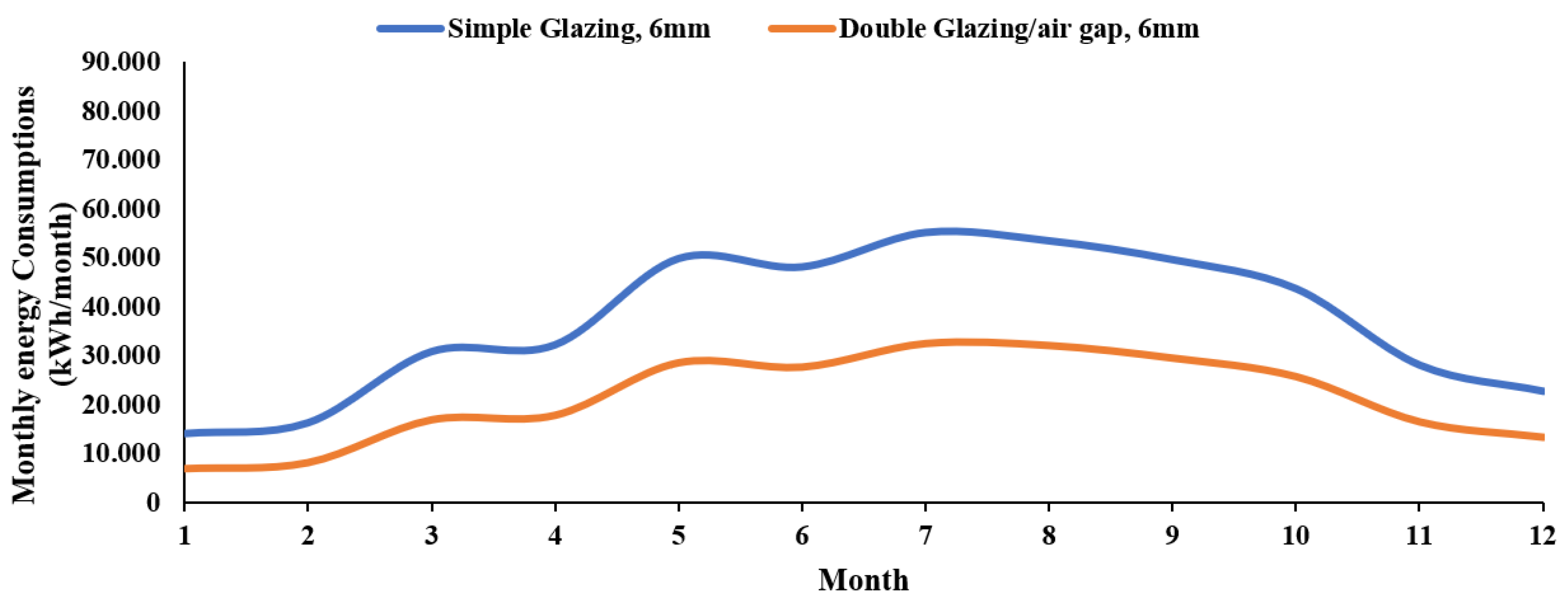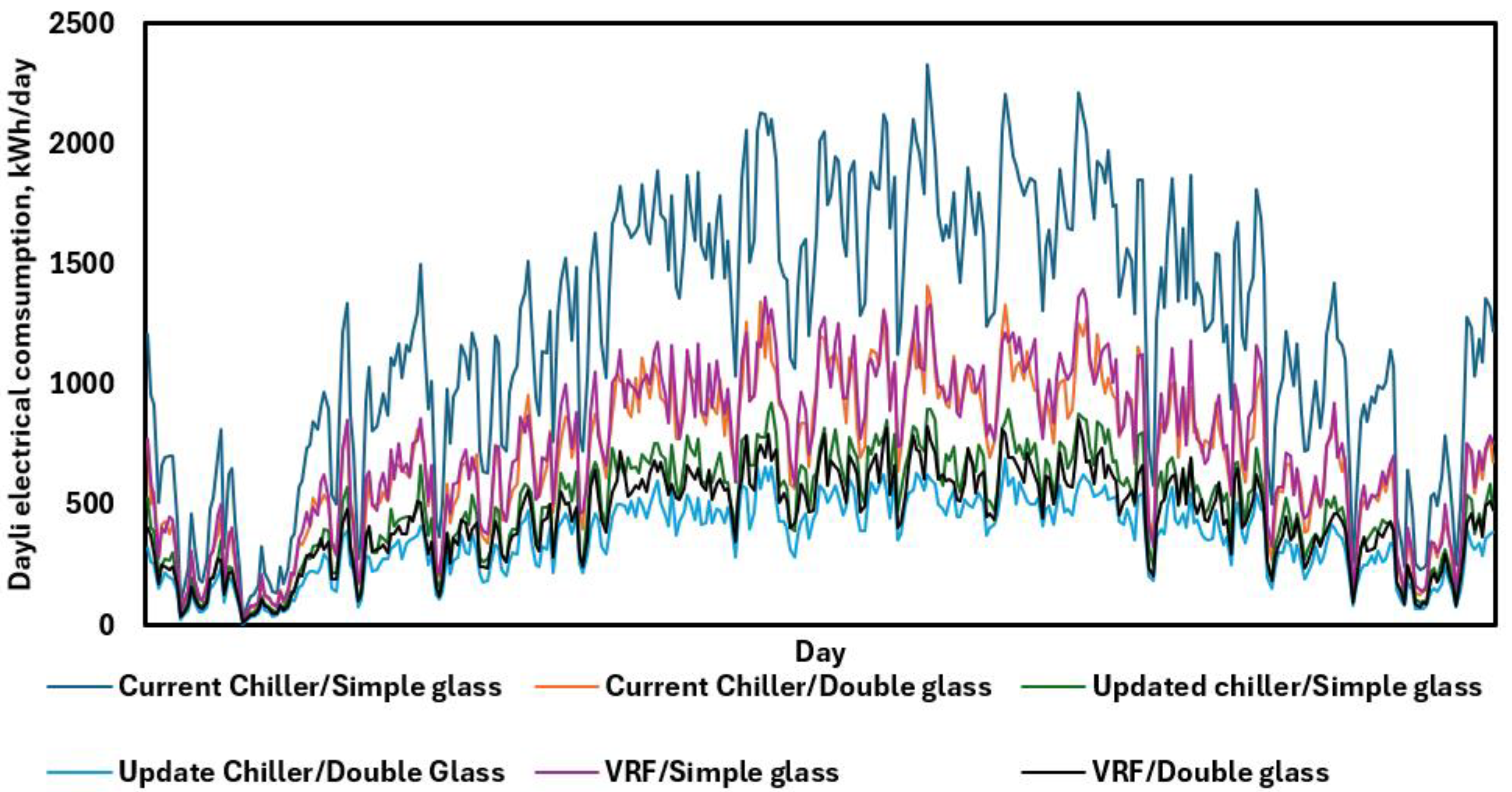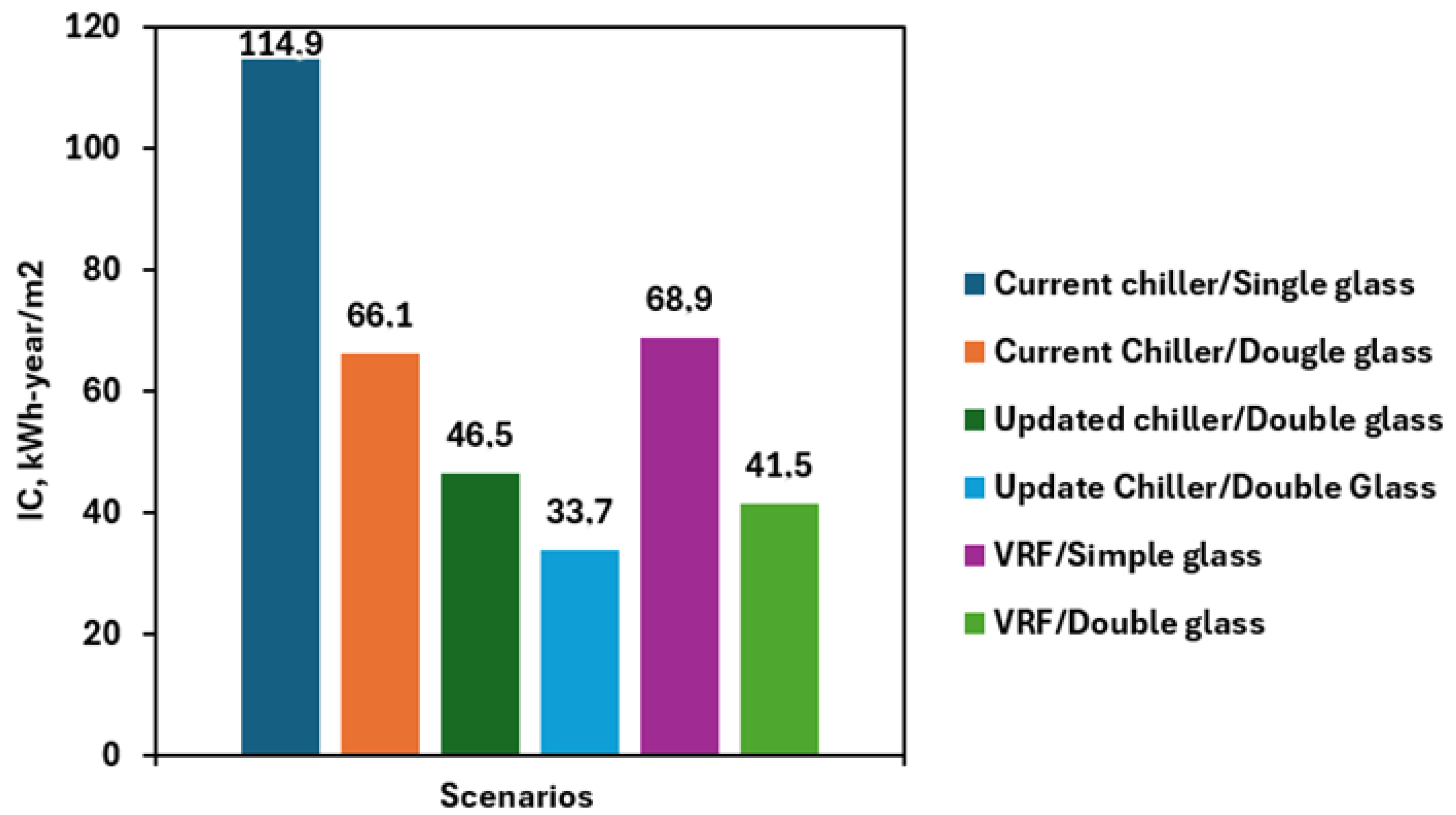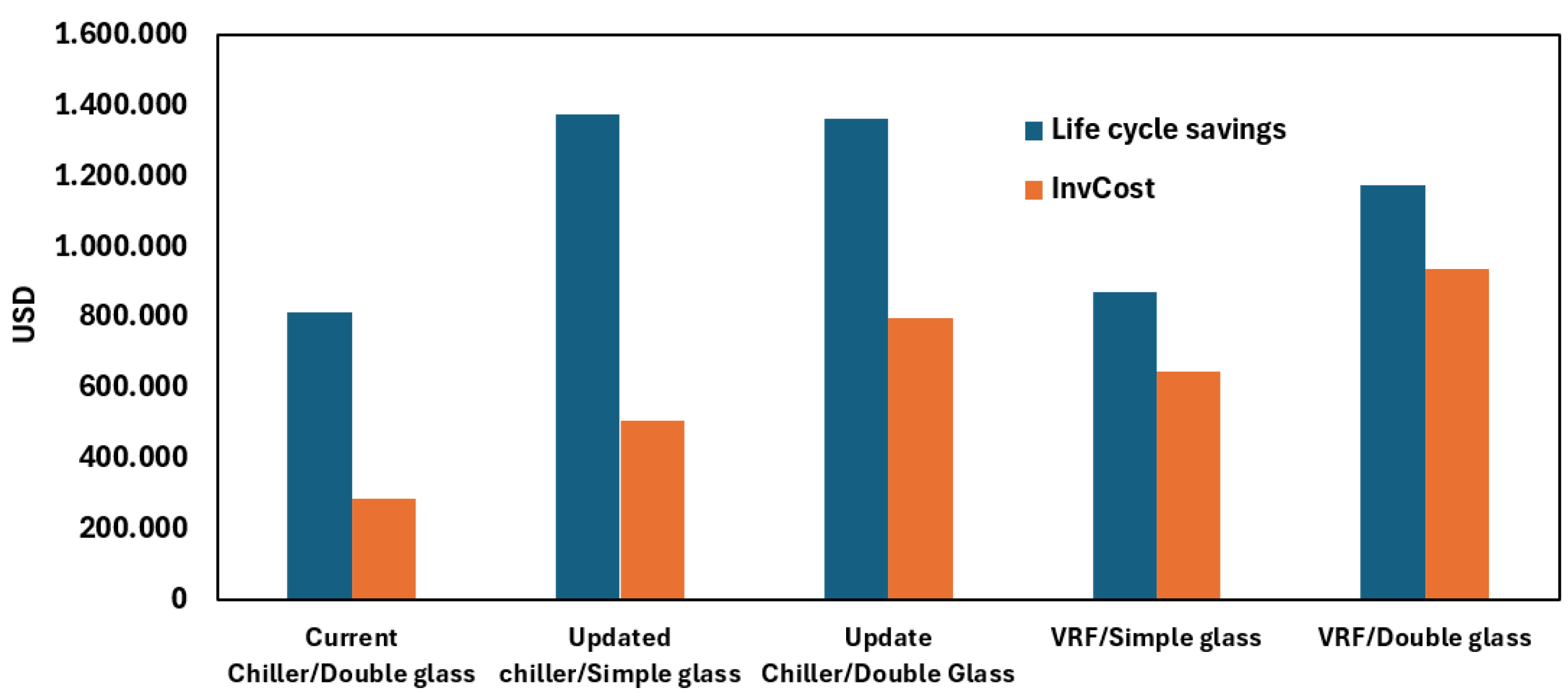1. Introduction
Buildings have been pointed out as one of the leading energy consumers worldwide, accounting for around 40% of primary energy in most countries [
1]. Although minimum performance standards and building energy codes are increasing in most countries, efficient and renewable building technologies are improving continuously, and the need to accelerate the change is recognized [
2].
As buildings’ life spans are long and a large part of the current building stock will exist in 2050, retrofitting the existing stock is critical to a low-emission building sector [
1]. Therefore, improving the energy performance of existing buildings is considered the most effective way to reduce energy consumption significantly in the building sector [
3], and building retrofit allows for cost-effective measures to be taken and transformed into resource-efficient and environmentally friendly buildings [
4].
Because of the extensive building inventories, many developed countries have implemented policies and regulations to assess and enhance building energy performance [
5]. However, this issue receives less attention in developing countries due to the lack of investment financing, the absence of fiscal incentives, and the uncertainty of a profitable initial investment return [
6].
Building retrofit has a high capacity to contribute to the global goals of climate change mitigation [
7]. Energy is significant behind this effect; a 42% reduction in electricity and a 35% possible reduction in the building sector of gas consumption capacity in the European Union are estimated through existing building modernization [
8]. Developing an effective building retrofit necessitates comprehensively analyzing all solutions involving planimetric and volumetric modifications and eliminating outdated building parts focused not only on functional and aesthetic issues but also on minimizing environmental impact, such as energy and resource consumption, emissions of air and water pollutants, and waste generation, to enhance indoor comfort [
7].
The energy-saving component in retrofitting existing buildings involves implementing electricity-saving improvements in heating, ventilation, and air conditioning (HVAC) systems; monitoring systems; lighting systems; domestic hot water systems; and building envelope systems [
9].
Hotel buildings differ significantly from other public and commercial buildings because of their varying size, diversity of facilities, and operating schedules, and their goal is focused mainly on satisfying the guests’ expectations [
10]. The hotels are the second most energy-intensive buildings after hospitals [
11], and their building retrofit is an attractive opportunity to improve energy performance. However, the significant investment required for retrofitting and upgrading systems, which can often run into millions of dollars, can financially burden many hotel operators. [
12]
Hotel buildings possess characteristics that must be accounted for, including energy performance improvement in retrofit development. These include seasonal energy demand fluctuations and significant energy consumption unrelated to overnight stays [
13]. Nevertheless, the wide variety of hotel buildings, with different ages, forms, dimensions, and locations in various climatic zones, do not allow for only one approach to energy retrofit. Therefore, the retrofit interventions must be carefully defined and designed for better results [
14]. The asset of the energy retrofitting action results is based on the possible energy savings and cost; in the hotel’s case, this must be achieved without affecting the satisfaction and comfort of guests. Actions can be classified in three ways: operation and maintenance, retrofitting of the building, and obsolete equipment replacement [
15].
Tourism is one of Cuba’s primary sources of foreign exchange and employment, contributing significantly to the economy [
16]. In recent years, significant investments have been made in modernizing new and old hotels [
17]. Although the tourism sector and hotels have a considerable share of national electricity consumption, there is no evidence that energy factors are frequently considered in hotel renovations [
18]. One of the causes is that acquiring new technologies is commonly precluded and usually lacks the necessary funds for most Cuban hotels. Also, the level of implementation of energy management is low, and few works are reported in the specialized literature referring to the energy problems of Cuban hotels [
19].
This study uses dynamic simulation with Design Builder software to conduct a hotel’s energy assessment in Cienfuegos, Cuba, before and after its retrofit. The aim is to assess the energy performance of the building with the carried-out retrofit and whether energy-saving passive measures, such as replacing glass (single and double glazing) and active measures related to air conditioning (AC) technologies, have been implemented. The comparison includes the current chilled water (chiller) system and a VRF system as potential improvement alternatives to assess the cost of neglecting energy factors when undertaking hotel reconstruction projects under Cuba’s conditions.
2. Methodology
Evaluating and forecasting a building’s energy consumption is crucial for understanding and optimizing its energy performance, and building energy simulation is a primary tool. The energy assessment in this study followed the steps shown in
Figure 1 [
20].
First, detailed information about the building is collected from plans and technical specifications, such as used materials, lighting, climatization technologies, operation regimes, and directional orientation. The climate data of the area, including temperatures, humidity, and hours of sunshine, must also be collected.
Second, a digital building model is created using Design Builder software because of its user-friendly interface, detailed geometry input options, and integration with the EnrgyPlus simulation engine. It allows for evaluating HVAC systems, building envelope materials, internal loads, and climate data. Although this study did not compare its results with other software, prior research has validated Design Builder’s reliability for similar building types and climates [
21,
22].
This model includes essential details such as building geometry, materials, and specifications for windows and doors. Next, the simulation parameters and conditions are defined, setting specific climatic factors like outside temperatures, relative humidity, and solar radiation, as well as the internal operating conditions, including occupancy levels.
Third, the model is configured, and technical parameters and efficiency values for the AC system, lighting, and equipment are established. Second, a digital building model is created using Design Builder software.
Next, the building energy simulation is computed to validate if the results are consistent and adequately represent electricity consumption for the different conditions through comparison with measured data for the same conditions of the model. Then, the model can simulate the building energy performance for various conditions and technologies.
In this study, the building model was computed for the conditions of the retrofit carried out, and whether specific passive and active energy-saving measures would have been introduced, establishing their economic feasibility and the cost of ignoring them due to missing the energy focus in the retrofit planning.
2.1. Buildings Energy Performance Assessment
Determining energy consumption is essential to assess the building’s energy performance; there are several methods for doing it, on which computer simulation is based. In this study, the Design Builder software, version 4.7, was used for the energy simulation due to its wide use and recognized performance, which applies the EnergyPlus calculation engine and the transfer function (TF) [
21,
22] shown next.
where
is the cooled space load,
is the heat gain, and
are the transfer function coefficients.
The relationship between the building’s thermal load and the energy performance of AC defines the energy consumption (EC). The energy demanded by each AC technology is calculated by integrating their load function and the energy consumed by dividing the building’s thermal load function by the stational efficiency of the thermal installation (see Equation (2)).
where
: Energy consumption of AC system;
: AC technology load function;
: Building’s thermal load function;
: Stational thermal efficiency of AC system;
to, tf: Initial and final time.
The intensity of energy use (kWh/m
2) behavior in a typical year of operations is used as an energy performance indicator (
IC) to assess the building energy performance [
23]. For the energy assessment of AC systems, the global efficiency index shown in Equation (3) is applied [
24]
The building’s energy performance assessment for different AC technologies (chiller and VRF) and the change of glass in the room windows (single and double) was carried out through energy simulation. The energy consumption index per conditioned area (
IC) was calculated for each configuration. The results were the starting point of the life cycle cost (LCC) when comparing the under-study configurations. The thermal load of the building in the air-conditioned areas was obtained from the simulation of each AC technology and type of glazing. The yearly energy consumption (EC) was also obtained from the simulation. According to data from specialized Cuban companies, the operating and maintenance costs for the AC system span a life of 10 years. Also, the investment cost was estimated according to market values. The total net present value (
) throughout the life cycle [
22] was calculated as follows:
where
VPNcv is the sum of the yearly
VPNn for the 20 years of the AC spam life, the base investment cost is considered as the first year, and
is the difference in the annual energy cost of conditioning the building for the different alternatives in the year of analysis
n, and a discount rate
d.
2.2. Case Study
The study was conducted in a hotel located in the municipality of Cienfuegos (22°08′44″ N, 80°26′11″ W) in the central-southern part of Cuba. According to Köppen and Geiger’s climatic classification, the climate is tropical savanna (Aw). This location has an average annual temperature of approximately 25 °C and a relative humidity exceeding 75%. The hotel has been in operation since 1959 and has undergone several renovations, with no evidence of passive measures being implemented to improve its energy performance. In 2002, its air conditioning system was replaced with the one currently operating [
25].
The hotel is a seven-level block, with a ground floor featuring a high clearance for the lobby and services and six room floors. A vertical module is inserted at the center of this block, serving as a shaft for three elevators and a staircase. Rooms are distributed at 23 per floor across the building’s six levels. Each is 4 m wide, 7 m long, and 3.30 m high. The room access is for the northern facade (see
Figure 2), while on the southern facade, each room has a balcony and a glazed wall of approximately eight m
2, covered with curtains (see
Figure 2). The lobby on the first floor is the highest level at 6.10 m.
Figure 3 shows the top view of the floors.
The hotel’s energy performance has been previously studied [
26], and it is evident that the AC system shares around 60% of yearly electricity consumption. The air conditioning system’s obsolescence and high energy consumption are recognized [
27] in research focused on developing a predictive control strategy to optimize its operation based on environmental and operational variables, minimizing electricity use while ensuring comfort. The thermal load simulation of the building for August in the TRNSYS 18 software (assuming full occupancy) resulted in 195,000 kWh/month. The proposed control strategy is based on the automatic adjustment of the chilled water temperature in the chiller, and the simulation estimated a potential electricity savings of 8.
Since the AC’s cold water distribution system has six different circuits based on the determination of the hourly thermal load for each circuit for each Cuban climatic season and different occupancy levels through energy simulation in TRNSYS, operational strategies were proposed that established the operating schedule for each circuit, setting the cold water temperature by season, and regulating the water flow, with a potential savings of 11% of the energy consumed by the AC system [
28].
The retrofit was focused on two issues: the improvement of outdoor spaces and the room update. During the reconstruction, a complete renovation of the residential block was carried out, which will now have a typical floor plan repeated the same way on the hotel’s six residential levels. Although the number of rooms on each floor was kept, 34 interior partition walls were removed to allow for a new distribution of spaces using lightweight partition walls. Additionally, an entire plasterboard ceiling was installed throughout the area, and wood-look porcelain flooring was laid in all the rooms; their internal structure was significantly modified according to the change in room type. Finally, the hotel has 60 married rooms; 66 double rooms, 4 × 7 × 3.3 m; six suites, 8 × 7 × 3.3 m; and six housekeeping stations (one per floor), resulting in 3864 m2 of air-conditioned space and 1104 m2 of glazed wall area on the exterior balconies of the rooms.
The retrofit process lasted over a year, with the hotel closing and significant costs for rooms not sold. Although energy security is one of the main issues in Cuba, where intense and frequent blackouts occur daily [
28], energy efficiency is a political priority [
29]. Any energy consideration was analyzed in the retrofit planning despite the opportunity to take advantage of the closed time and the usual short recovery time of this kind of inversion in energy savings in a very energy-intensive process.
2.3. Building’s Model
Figure 4 shows the 3D model developed in design building software for the hotel energy assessment.
Table 1 shows the building’s material transmittance. The values for materials before retrofit were calculated from previous data [
28] and the materials proposed as energy-saving measures from the literature.
Two types of materials were evaluated for the windows, which cover 60% of the south facade wall of the building in each room. The first option is the existing 6mm single-pane glass used in the current windows, with a Solar Heat Gain Coefficient (SHGC) 0.7. The second option is a potential replacement with 6mm double-pane glass featuring an air chamber with an air chamber and an SHGC of 0.2. This difference in SHGC values plays a significant role in reducing solar heat gain and improving the overall energy performance of the building.
The building’s AC system has three chillers and uses R-134a refrigerant with two independent cooling circuits. The system has two semi-hermetic screw compressors with constant flow, capacity regulation in steps of 25%, a cooling capacity of 113 TR (398 kW), a COP of 2.2, and a chilled water flow of 61.56 m
3/h. Its dimensions are 4 m long, 2.26 m wide, and 2.5 m high, with an operating weight of 4180 kg.
Figure 5 shows the configuration of the AC chiller system used for the building’s energy simulation.
The building’s AC system is over twenty years old, with three chillers and R-134a refrigerant with two independent cooling circuits. The system has two semi-hermetic screw compressors with constant flow, capacity regulation in steps of 25%, a cooling capacity of 113 TR (398 kW), a COP of 2.2, and a chilled water flow of 61.56 m
3/h. Its dimensions are 4 m long, 2.26 m wide, and 2.5 m high, with an operating weight of 4180 kg.
Figure 3 shows the configuration of the AC chiller system used for the building’s energy simulation.
Despite the building’s AC systems’ age and low efficiency, their replacement was not considered in the retrofit planning because of the high investment cost, which did not include energy-saving benefits in the analysis. To generate a complete vision of the economic consequences of continuing to operate the current AC system, its replacement was modeled in two variants:
3. Results and Discussion
A building retrofit can positively impact energy consumption if the energy issues have been adequately considered [
30]. Passive and active energy-saving measures adopted during building retrofit can reduce energy consumption between 50% and 80% [
31,
32].
Initially, a simulation of the hotel building before and after the retrofit processes is conducted to establish he impact on energy consumption. The occupation and climatic data for 2021 and from the first twelve months of hotel operation after retrofit were used to compute the building model (see
Figure 4) and validate it with actual hotel electricity consumption. The simulation was carried out with the initial hotel configuration and included the structural transformations from retrofit; the lighting and AC system were not modified in retrofit.
Table 2 shows the results.
Table 2 shows that retrofitting does not significantly change building energy consumption, increasing yearly energy consumption by approximately 1% (4316 kWh). Therefore, it is a useful baseline for assessing the effect of passive and active energy-saving measures on energy consumption and economic performance.
The statistical analysis compared the real measurements with the modeled values before and after retrofit using a paired t-test and a Bland–Altman test. This evidences that there is not a significant difference between the means of the measured and modeled data, indicating that the model does not have a systematic bias. The average difference (bias) was negligible, and its confidence interval included zero, confirming that the model neither consistently overestimates nor underestimates the real values. Also, the test showed that 95% of the differences between measured and modeled values fell within an acceptable range, with no apparent error trend increasing with higher values. The model’s errors were randomly distributed and within typical accuracy standards for energy models. The results prove that the real measurements validate the obtained energy building model, demonstrating good accuracy. The results are summarized in
Table 3.
3.1. Energy Savings by Window Replacement
The retrofit increased the room’s exterior facades’ glazing area by 2%. The building’s energy consumption is assessed, replacing the currently installed 6 mm single glass with high transmittance (U) with double glass with an air chamber of lower U (see
Table 1).
Figure 6 shows the actual monthly electricity consumption after the remodeling and the consumption predicted by energy modeling if others replaced the windows with lower transmittance. The yearly energy consumption with the current windows was 444,356.9 kWh, while with the glass double pane with an air chamber, it was 255,200.7 kWh. The 42% reduction is close to the expected electricity consumption [
33,
34] because this glass facade is the main contributor to the thermal load in the rooms that constitute the primary cooling demand of the installation.
3.2. Air Conditioning Technology Replacement
Two technological alternatives to reducing energy consumption for AC were considered. The replacement of the current inefficient chiller with an updated, more efficient one, and because VRF operates at partial load and full load, saving 30% and 14% energy, respectively, compared to the Chiller, this technology was also considered.
The result of each AC technology shows as the current chiller presents the highest monthly electricity consumption and total yearly consumption of 444,356.90 kWh, and the updated chiller has an annual consumption of 266,603.58 kWh, which is 40% less. In comparison, the VRF has a reduction of 59.5%, resulting in a yearly consumption of 179,739.8 kWh. The literature reports that VRF AC systems are more efficient, consume less energy, and are easier to operate than centralized HVAC systems [
33]. However, according to the specialized literature [
34], the high-efficiency AC chiller system performed better for this large hotel building. Therefore, the best technology for energy consumption is an undated chiller, which would result in 10% more energy savings than VFR.
3.3. Energy Consumption Combining Windows and AC Replacement
The building’s IC was almost constant with the retrofit: before, it was 114 kWh/m
2, and after, it was 115 kWh/m
2 using the same Chiller-type AC system and single-glass windows. Since the building energy modeling for replacing the windows and AC system evidenced a significant energy-saving potential (see
Figure 6 and
Figure 7), scenarios combining energy-saving measures were also studied from energy simulation with 2023 data. The results of the 15 April daily energy consumption are shown in
Figure 8.
The current chiller with simple glass is the baseline with the highest energy consumption (444,356.9 kWh/year). Combining the current chiller with double glass results in a 43% yearly energy savings, reaching a consumption of 255,564.8 kW. The updated chiller, combined with simple (179,385.0 kWh/year) and double glass (130,871.4 kWh/year), has energy savings of 60% and 71%, respectively. The VRF combined with simple glass has a yearly energy consumption of 265,180.2 kWh/year (41% saving), and with double glass, 161,011.1 kWh/year (44% saving).
Figure 9 shows the IC for combinations of AC technology and simple or double glass in windows, evidencing that the combination with the best energy performance is the updated chiller with double glass windows, with an IC almost four times lower than that of the combination taken as a baseline and three times that of simple glass. The figure also shows a significant improvement in the hotel’s energy performance combined with the energy-saving measures, but an in-depth analysis is necessary to establish which combination is better.
3.4. Life Cycle Cost (LCC) Analysis for Energy-Saving Measures Combination
For the LCC analysis, the investment (InvCost) and operation costs (OpCost) of each AC technology and the cost of replacing windows for double glass (WRC) have been estimated according to market proposals. The OpCost has two components: energy cost and maintenance cost. Energy costs have been calculated for each AC system from yearly energy consumption by energy simulation with 2023 data (see
Figure 8), and the electricity rate for foreign investment in Cuba was established at 0.25 USD/kWh [
35]. Maintenance costs are calculated from the average service quote of several specialized companies in the Cuban market. The InvCost has two components: the cost of AC equipment or double glass windows, calculated from the average quote of similar goods in the Cuban market, and the installation and assembly cost, calculated from commercial quotes.
For the LCC, the 20-year lifespan of all AC technologies was considered [
36]. The average annual growth rate is 5% [
37]. The discount rate (n) established is 3.5% [
38]. The results are shown in
Table 4.
The results in
Table 4 show that with investment increases in the hotel retrofit between USD 288,000 and 935,000, not only would significant improvements in the hotel’s energy performance be achieved, but significant economic savings over the life cycle of the AC systems would also be achieved, as shown in
Figure 10.
Figure 10 shows the life cycle savings for each scenario analyzed and the investment costs that would have been required. Installing an updated chiller, taking advantage of the current AC system structure, is the most satisfactory, as an investment of USD 508,600 would yield savings of USD 1,373,500 compared to the baseline scenario, which does not consider energy issues in the retrofit. Due to the difficulty in financing investments in the Cuban economy, replacing the window glass is also attractive, as an investment of USD 508,000 would achieve life cycle savings of over USD 800,000.
To further strengthen the financial assessment of the retrofit alternatives, a sensitivity analysis was carried out assuming a 5% annual increase in electricity prices over a 20-year period. Both the updated chiller and VRF scenarios demonstrated strong economic performance. The updated chiller combined with double glazing achieved the shortest payback period (3.7 years), followed by the VRF system (4.2 years).
3.5. Cost-Effectiveness and Computational Complexity of the Surveyed Methods
Researchers often rely on building performance simulation (BPS) tools to evaluate buildings in need of retrofit and analyze the impact of specific intervention strategies. These physics-based models allow for comparing various retrofit options and help determine the most appropriate approach for each building [
39]. This study demonstrates that physics-based models such as EnergyPlus, used through the Design Builder interface, provide a cost-effective and reliable approach to evaluating retrofit strategies in energy-intensive buildings [
40].
Although BPS methods can be computationally demanding due to data input, calibration, and the need for professionals with knowledge and proficiency in the software [
41,
42], the model developed in this research-oriented study required approximately 15 to 20 min per annual simulation on a standard workstation. The modeling process achieved a productivity rate of around 80 to 100 m
2/h, considering a researcher with experience and no direct BIM integration. This balance between detail and efficiency led to the conclusion that it is possible to perform replicable scenario testing without the need for high-performance computing infrastructure.
In comparison with more advanced approaches that use surrogate models and machine learning for large-scale analysis or optimization of different building types applied to specific case studies [
39,
43], this study prioritizes transparency and accessibility through the use of widely available software endorsed by ASHRAE, suitable for professional use in contexts with limited computational or financial resources. However, the future incorporation of surrogate-based optimization frameworks is not ruled out, as they could further reduce simulation time while allowing for exploring a broader range of intervention strategies.
4. Policy Implications
As the tourism sector consumes between 7% and 9% of the electricity used by the productive sector in Cuba [
44], national energy rational use policies have focused on this sector. The main action lines include incorporating renewable energy sources (solar thermal, photovoltaic solar, biomass) in hotel facilities, introducing bioclimatic architectural designs, replacing high-consumption equipment with energy-efficient technologies, and implementing automated demand control and management systems [
45].
Despite these efforts, Cuban hotels’ electricity consumption per functional area remains above international benchmarks. This is mainly due to the country’s insufficient technological infrastructure, which generates a high dependency on foreign technologies and commercial restrictions arising from U.S. sanctions [
46]. This increases investment costs and extends the payback period of energy-saving measures. Current energy efficiency policies are insufficient to achieve better results in the coming years. The indicators used do not address the main drivers of energy consumption, and there is still no firm commitment to include, as part of energy-saving actions, equipment for energy generation through renewable sources or large-scale investments in more efficient air conditioning systems [
19].
In the last five years, more than USD 2000 million have been invested in the Cuban hotel sector, leading to significant renovations and new hotel openings in various regions. During this period, more than 30 hotels of different sizes have been renovated, focusing primarily on lighting replacement and, in some cases, the limited implementation of solar energy for electricity generation and domestic hot water production [
47].
The current national context conditions are still insufficient to foster better energy efficiency actions in buildings, and there are no regulations or financial mechanisms to promote them. During the investment stage, the Cuban Standards, called “Bases for the Design and Construction of Tourist Investments”, are applied in the tourism sector [
47]. These standards define global indicators for calculating maximum electricity and water consumption based on the number of rooms, hotel category, and type of AC system, allowing for a reference in establishing energy baselines [
48]. However, Cuba has not yet developed a strategy to reduce energy consumption and generate energy in buildings. There are no national standards regarding the consumption range they should have nor incentives for conducting energy analyses when undertaking hotel renovations.
This study shows that economic opportunity is lost when undertaking hotel renovations without sufficiently considering energy issues. Improving energy performance significantly allows for the recovery of investments within reasonable timeframes, especially when considering the losses incurred by a hotel’s temporary closure.
5. Conclusions
This study highlights the significant gap in hotel retrofits that fail to incorporate energy performance improvements, leading to missed financial opportunities. One of the major costs associated with hotel renovations is operational downtime and lost revenue from unsold rooms and services. To minimize these costs, retrofits must be as comprehensive as possible, integrating energy efficiency measures alongside facility upgrades to optimize operational and financial performance.
In the subtropical weather tourism sector, hotel renovations typically focus on enhancing guest experience by improving amenities and services, with limited attention paid to energy performance due to financing challenges. This study demonstrates the need for a shift in this approach. By quantifying the economic impact of excluding energy considerations during renovation planning, the study shows that each dollar invested in energy-saving measures can yield approximately USD 2.5 in life cycle savings, considering both energy cost reductions and maintenance over the system’s operational lifespan.
The findings underscore the critical importance of integrating energy efficiency into hotel retrofits, especially in Cuba’s ongoing energy crisis. As energy demand decreases, implementing energy-saving measures becomes essential for the sustainability of the hospitality sector. The study provides a method to properly assess the viability of energy investments in hotel retrofits, offering a framework that could be applied in both Cuban and global contexts.
Energy-saving measures such as replacing single-glazed windows with double glazing and upgrading air conditioning systems significantly improve energy efficiency. In the case studied, replacing windows alone resulted in a 42% reduction in annual energy consumption, while updating the chiller system achieved 40% savings. The most impactful combination—double glazing and an updated chiller—led to a 71% reduction in energy consumption, with a life cycle cost analysis indicating substantial financial benefits.
Other energy efficiency measures not considered would contribute to additional improvements and should be considered. Since the previous studies for current hotel’s AC systems point to a 9% energy-saving potential [
27], introducing predictive control to drive the chiller behavior, and 11% optimizing operational parameters of the chiller and the six chilled water distribution circuits [
28], these measures should be considered in the simulation of the work of the evaluated updated AC systems, which would contribute to a more accurate feasibility calculation.
Additionally, other passive energy measures should be considered for future retrofit, such as installing sunshade awnings on the south facade to reduce direct solar radiation on the glass doors of the balconies, using insulating curtains behind decorative curtains on balcony doors, and increasing the density of trees in the gardens to prevent direct sunlight from hitting the lobby, restaurant, and first floor’s windows. Furthermore, the thermal properties of the building envelope exhibit relatively high U-values and limited thermal resistance, which increases the building’s cooling demand. Therefore, enhancing the envelope—beyond glazing—could lead to more significant energy savings.
This study emphasizes that failing to consider energy performance during hotel renovations results in long-term economic losses. Integrating comprehensive energy efficiency measures into renovation planning reduces operational costs, and it enhances the long-term financial viability of hotel investments. This approach is crucial for ensuring the sustainability of the hospitality industry, particularly in energy-constrained environments.
Author Contributions
Conceptualization, M.B.M. and J.J.C.E.; methodology, J.J.C.E. and F.J.R.-M.; software, O.C.J. and M.B.M.; validation, J.J.C.E., M.B.M., O.C.J. and J.M.R.-H.; formal analysis, M.B.M. and J.M.R.-H.; investigation, O.C.J., M.B.M., O.C.J., F.J.R.-M. and J.M.R.-H.; resources, F.J.R.-M.; data curation, O.C.J., M.B.M., O.C.J., F.J.R.-M. and J.M.R.-H.; writing—original draft preparation, O.C.J., M.B.M. and O.C.J.; writing—review and editing, O.C.J., M.B.M., O.C.J., F.J.R.-M. and J.M.R.-H.; visualization, O.C.J., M.B.M., O.C.J., F.J.R.-M. and J.M.R.-H.; supervision, F.J.R.-M., M.B.M. and O.C.J.; project administration, M.B.M. All authors have read and agreed to the published version of the manuscript.
Funding
This research received no external funding.
Data Availability Statement
Data is available under request.
Acknowledgments
We would like to express our sincere gratitude for the support provided by the Ibero-American Program of Science and Technology for Development (CYTED) through the TRAPECIO Network as well as the EUSUVa4.0 Project, Lime4Health Project, and LIFE23-CET-Re-Energize Project.
Conflicts of Interest
The authors have no conflicts of interest to disclose.
References
- IPCC. Climate Change 2022—Mitigation of Climate Change—Full Report; IPCC: Geneva, Switzerland, 2022; ISBN 9781107415416. [Google Scholar]
- Economidou, M.; Todeschi, V.; Bertoldi, P.; D’Agostino, D.; Zangheri, P.; Castellazzi, L. Review of 50 years of EU energy efficiency policies for buildings. Energy Build. 2020, 225, 110322. [Google Scholar] [CrossRef]
- Ballarini, I.; Corgnati, S.P.; Corrado, V. Use of reference buildings to assess the energy saving potentials of the residential building stock: The experience of TABULA project. Energy Policy 2014, 68, 273–284. [Google Scholar] [CrossRef]
- Poel, B.; van Cruchten, G.; Balaras, C.A. Energy performance assessment of existing dwellings. Energy Build. 2007, 39, 393–403. [Google Scholar] [CrossRef]
- Berardi, U. A cross-country comparison of the building energy consumptions and their trends. Resour. Conserv. Recycl. 2016, 123, 230–241. [Google Scholar] [CrossRef]
- Bertolazzi, A.; Micocci, F. SOLEH (Sustainable Operation Low-cost Energy for Hotels). Innovative tools and guidelines for the sustainable hotels’ refurbishment. IOP Conf. Ser. Earth Environ. Sci. 2023, 1196, 012009. [Google Scholar] [CrossRef]
- Ardente, F.; Beccali, M.; Cellura, M.; Mistretta, M. Energy and environmental benefits in public buildings as a result of retrofit actions. Renew. Sustain. Energy Rev. 2011, 15, 460–470. [Google Scholar] [CrossRef]
- Commission, E. Roadmap to a Resource Efficient Europe. 2011. Available online: https://www.eea.europa.eu/policy-documents/com-2011-571-roadmap-to (accessed on 26 November 2024).
- Marjianto, A.; Hafthirman, H.; Darmanto, P.S. Energy and Cost Saving Potential of Hotel Air Conditioning Using Magnetic Bearing Chiller in Jakarta. Int. J. Innov. Mech. Eng. Adv. Mater. 2021, 3, 1. [Google Scholar] [CrossRef]
- Kresteniti, A. Development of a Concept for Energy Optimization of Existing Greek Hotel Buildings. Procedia Environ. Sci. 2017, 38, 290–297. [Google Scholar] [CrossRef]
- Arenhart, R.S.; Souza, A.M.; Zanini, R.R. Energy Use and Its Key Factors in Hotel Chains. Sustainability 2022, 14, 8239. [Google Scholar] [CrossRef]
- Madushika, U.G.D.; Ramachandra, T.; Karunasena, G.; Udakara, P.A.D.S. Energy Retrofitting Technologies of Buildings: A Review-Based Assessment. Energies 2023, 16, 4924. [Google Scholar] [CrossRef]
- Santamouris, M.; Balaras, C.A.; Dascalaki, E.; Argiriou, A.; Gaglia, A. Energy conservation and retrofitting potential in Hellenic hotels. Energy Build. 1996, 24, 65–75. [Google Scholar] [CrossRef]
- Pina, A.; Ferrão, P.; Fournier, J.; Lacarrière, B.; Corre, O. Le ScienceDirect ScienceDirect HVAC solutions for energy retrofitted hotel Heating in Mediterranean area Assessing the feasibility of using the heat temperature function Prendin for a long-term district heat demand forecast. Energy Procedia 2017, 133, 145–157. [Google Scholar]
- Droutsa, K.G.; Balaras, C.A.; Dascalaki, E.G.; Kontoyiannidis, S.; Argiriou, A.A. Energy Use Intensities for Asset Rating of Hellenic Non-Residential Buildings. Glob. J. Energy Technol. Res. Updat. 2018, 5, 19–36. Available online: http://cms.ashrae.biz/EUI (accessed on 26 November 2024). [CrossRef]
- Hingtgen, N.; Kline, C.; Fernandes, L.; McGehee, N.G. Cuba in transition: Tourism industry perceptions of entrepreneurial change. Tour. Manag. 2015, 50, 184–193. [Google Scholar] [CrossRef]
- Nuñez, J.; Torres, B.; Benítez, I.; Milanés, C.B.; Noriega, E. Tools for the Implementation of an Inmotic System in the Imperial Hotel in Santiago de Cuba, Cuba. IOP Conf. Ser. Mater. Sci. Eng. 2021, 1154, 012004. [Google Scholar] [CrossRef]
- Baldoquin, N.C.; Couret, D.G.; Guzmán, L.A.R. Energy Retrofit of Traditional Buildings in a Warm-Humid Urban Climate. In Achieving Building Comfort by Natural Means. Innovative Renewable Energy; Springer: Cham, Switzerland, 2022; pp. 451–472. [Google Scholar]
- Cabello Eras, J.J.; Sousa Santos, V.; Sagastume Gutiérrez, A.; Guerra Plasencia, M.Á.; Haeseldonckx, D.; Vandecasteele, C. Tools to improve forecasting and control of the electricity consumption in hotels. J. Clean. Prod. 2016, 137, 803–812. [Google Scholar] [CrossRef]
- Rey, F.; Velazco, E.; Rey Martínez, F. Eficiencia Energética de los Edificios. Sistema de Gestión Energética iso 50001. In Auditorías Energéticas, 1st ed.; PARANINFO: Madrid, Spain, 2018. [Google Scholar]
- Rey-Hernández, J.M.; San José-Alonso, J.F.; Velasco-Gómez, E.; Yousif, C.; Rey-Martínez, F.J. Performance analysis of a hybrid ventilation system in a near zero energy building. Build. Environ. 2020, 185, 107265. [Google Scholar] [CrossRef]
- Balbis-Morejón, M.; Cabello-Eras, J.J.; Rey-Hernández, J.M.; Rey-Martínez, F.J. Energy evaluation and energy savings analysis with the 2 selection of ac systems in an educational building. Sustainability 2021, 13, 7527. [Google Scholar] [CrossRef]
- Dibene-Arriola, L.M.; Carrillo-González, F.M.; Quijas, S.; Rodríguez-Uribe, M.C. Energy efficiency indicators for hotel buildings. Sustainability 2021, 13, 1754. [Google Scholar] [CrossRef]
- Extension, K.P. Advanced HVAC Systems: Improving Energy Efficiency in Buildings. Res. Invent. J. Biol. Appl. Sci. 2024, 123, 2–6. [Google Scholar]
- Cabello, O. Evaluación de la Demanda Eléctrica del Sistema de Aire Acondicionado del Bloque Habitacional del Hotel Jagua by Meliá Mediante Simulación Energética en Design Building. PhD. Thesis, Cienfuegos University, Cienfuegos, Cuba, 2023. [Google Scholar]
- Torres, Y. Análisis energético de un sistema híbrido de producción de frío. Ing. Energética 2015, 36, 38–49. [Google Scholar]
- Lara, B.G.V.; Padrón, O.B.; Cigler, J.; Oldewurtel, F.; Borroto, M.Á.R. Model Predictive Control for a Tropical Island Hotel. In Proceedings of the 11th REHVA World Congress-CLIMA, Prague, Czech Republic, 16–19 June 2013. [Google Scholar]
- Díaz-Torres, Y.; Valdivia-Noda, Y.; Monteagudo-Yanes, J. Application of building energy simulation in the validating of operational strategies of HVAC systems on a tropical hotel. Ing. Mecánica 2017, 20, 31–38. Available online: http://www.redalyc.org/articulo.oa?id=225150396004 (accessed on 26 November 2024).
- Consejo de Ministros. República de Cuba. Decreto 110. Regulaciones Para el Control y Uso Eficiente de los Portadores Energéticos y las Fuentes Renovables de Energía. 2014, La habana. Available online: https://www.gacetaoficial.gob.cu/es/gaceta-oficial-no-115-ordinaria-de-2024 (accessed on 26 November 2024).
- Fan, Y.; Xia, X. Energy-efficiency building retrofit planning for green building compliance. Build. Environ. 2018, 136, 312–321. [Google Scholar] [CrossRef]
- Marco, M.; Ramezani, A.; Buoite Stella, A.; Pezzi, A. Climate Change and Building Renovation: Effects on Energy Consumption and Internal Comfort in a Social Housing Building in Northern Italy. Sustainability 2023, 15, 5931. [Google Scholar] [CrossRef]
- Herrera-Avellanosa, D.; Rose, J.; Thomsen, K.E.; Haas, F.; Leijonhufvud, G.; Brostrom, T.; Troi, A. Evaluating the Implementation of Energy Retrofits in Historic Buildings: A Demonstration of the Energy Conservation Potential and Lessons Learned for Upscaling. Heritage 2024, 7, 997–1013. [Google Scholar] [CrossRef]
- Yu, X.; Yan, D.; Sun, K.; Hong, T.; Zhu, D. Comparative study of the cooling energy performance of variable refrigerant flow systems and variable air volume systems in office buildings. Appl. Energy 2016, 183, 725–736. [Google Scholar] [CrossRef]
- Liu, M.; Shi, Y.; Fang, F. A new operation strategy for CCHP systems with hybrid chillers. Appl. Energy 2012, 95, 164–173. [Google Scholar] [CrossRef]
- Ministerio de Industría Comercio y Turismo. España COSTES DE ESTABLECIMIENTO EN CUBA; Ministerio de Industría Comercio y Turismo: Madrid, Spain, 2023; Available online: https://www.icex.es/content/dam/es/icex/costes/fichas-pdf/pdf_4747677_166686402.pdf (accessed on 24 November 2024).
- Hassan, N. Life Cycle Assessment of a CAV, a VAV, and an ACB System in a Modern Swedish Office Building. PhD Thesis, Lund University, Lund, Sweden, 2019. [Google Scholar]
- Unidad de Planeación Minero Energética (UPME). INFLACIÓN DE ENERGÍA EN COLOMBIA Enero 2021. Bogotá D.C., 2021. Available online: https://www1.upme.gov.co/DemandaEnergetica/Informe_Inflacion_Energia_Ene_2021.pdf (accessed on 25 November 2024).
- Stephens, B. The impacts of duct design on life cycle costs of central residential heating and air-conditioning systems. Energy Build. 2014, 82, 563–579. [Google Scholar] [CrossRef]
- Markarian, E.; Qiblawi, S.; Krishnan, S.; Divakaran, A.; Ramalingam Rethnam, O.; Thomas, A.; Azar, E. Informing building retrofits at low computational costs: A multi-objective optimisation using machine learning surrogates of building performance simulation models. J. Build. Perform. Simul. 2024, 1–17. [Google Scholar] [CrossRef]
- Liu, Y.; Zou, S.; Chen, H.; Wu, X.; Chen, W. Simulation Analysis and Scheme Optimization of Energy Consumption in Public Buildings. Adv. Civ. Eng. 2019, 2019, 6326138. [Google Scholar] [CrossRef]
- Daly, D.; Cooper, P.; Ma, Z. Understanding the risks and uncertainties introduced by common assumptions in energy simulations for Australian commercial buildings. Energy Build. 2014, 75, 382–393. [Google Scholar] [CrossRef]
- Lee, T.K.; Kim, J.U. A cost-effective and heuristic approach for building energy consumption prediction: BES model calibration and forecasting algorithm. Energy Build. 2024, 303, 113800. [Google Scholar] [CrossRef]
- Costa-Carrapiço, I.; Raslan, R.; González, J.N. A systematic review of genetic algorithm-based multi-objective optimisation for building retrofitting strategies towards energy efficiency. Energy Build. 2020, 210, 109690. [Google Scholar] [CrossRef]
- Iturralde Carrera, L.A.; Álvarez González, A.L.; Rodríguez-Reséndiz, J.; Álvarez-Alvarado, J.M. Selection of the Energy Performance Indicator for Hotels Based on ISO 50001: A Case Study. Sustainability 2023, 15, 1568. [Google Scholar] [CrossRef]
- Escobar, L.; De la Paz, G.A.; Herrera, G.; De la Paz, G. Evaluación de opciones de inversión en eficiencia energética y fuentes renovables de energía en hoteles de Santa Lucía, Camagüey. Rev. Arquit. Ing. 2022, 15, 5. Available online: https://dialnet.unirioja.es/servlet/articulo?codigo=8450697&info=resumen&idioma=ENG%0Ahttps://dialnet.unirioja.es/servlet/articulo?codigo=8450697&info=resumen&idioma=SPA%0Ahttps://dialnet.unirioja.es/servlet/articulo?codigo=8450697 (accessed on 1 September 2019).
- Guerra-Plasencia, M.Á.; Martínez-Santos, K.E. Metodología para el benchmarking energético de instalaciones hoteleras. Rev. UGC 2023, 1, 37–44. [Google Scholar]
- Collado Baldoquín, N.; Rueda Guzmán, L.; González Couret, D. Nearly zero energy hotels. Potentialities and restrictions for cuba. In Proceedings of the ECOSOLAR 2019, Garden Grove, CA, USA, 5 November 2019; pp. 33–44. [Google Scholar]
- Soto, C.R.B. Diseño de una Guía de Control para Evaluar el Desempeño Energético en Los Hoteles Del. Ph.D. Thesis, Universidad de la Habana, Havana, Cuba, 2023. [Google Scholar]
| Disclaimer/Publisher’s Note: The statements, opinions and data contained in all publications are solely those of the individual author(s) and contributor(s) and not of MDPI and/or the editor(s). MDPI and/or the editor(s) disclaim responsibility for any injury to people or property resulting from any ideas, methods, instructions or products referred to in the content. |
© 2025 by the authors. Licensee MDPI, Basel, Switzerland. This article is an open access article distributed under the terms and conditions of the Creative Commons Attribution (CC BY) license (https://creativecommons.org/licenses/by/4.0/).

